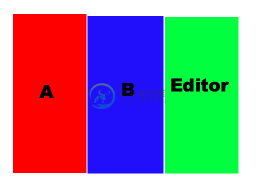Eclipse RCP IPageLayout的困境
我有一个具有三列布局的Eclipse RCP应用程序:

编辑器区域在最右边。现在,当您获得要使用的ipageLayout时,编辑器区域已经添加了。这很好:我们将区域B添加到编辑器的左侧,将区域A添加到B的左侧,布局正是我们所需要的。
问题是,当您在A和B之间移动窗框时,视图A和B会改变,而不会调整编辑器区域的大小(很好;)但是当您在B和编辑器区域之间移动另一个窗框时,所有三个视图的大小都被调整;布局管理器的作用是保持A和B的宽度比,这不是我们想要的。我们希望用户能够独立地移动每个窗框,并使它只影响它接触的两个视图。
-
null
共有1个答案
我知道在Eclipse3.x中没有办法改变ipageLayout的布局树。然而,在Eclipse4.2中,应用程序模型可以在运行时动态更改。
因此,如果您考虑将您的应用程序迁移到Eclipse4,这个解决方案可能是一个选择。为了尽可能保持原始应用程序和UI代码不受影响,此解决方案将
- 充分利用Eclipse4的兼容性层,从基于Eclipse3的RCP应用程序创建应用程序模型。不需要创建应用程序模型或更改应用程序的UI代码。
- 在应用程序处于活动状态后,重新排列编辑器区域的布局。这是通过在一个单独的插件中创建一个addon类来完成的。
- 允许将来更容易地迁移到Eclipse4的功能:如果您决定构建自己的应用程序模型,您只需解挂addon插件即可。
import org.eclipse.ui.IPageLayout;
import org.eclipse.ui.IPerspectiveFactory;
public class Perspective implements IPerspectiveFactory {
public static final String ID = "wag.perspective";
public void createInitialLayout(IPageLayout layout) {
String editorArea = layout.getEditorArea();
layout.setEditorAreaVisible(true);
layout.addStandaloneView(AView.ID, false, IPageLayout.LEFT,
0.25f, editorArea);
layout.addStandaloneView(BView.ID, false, IPageLayout.LEFT,
0.25f, editorArea);
layout.getViewLayout(AView.ID).setCloseable(false);
layout.getViewLayout(BView.ID).setCloseable(false);
}
}
然后我继续迁移应用程序并更改应用程序模型。
将基于Eclipse 3的RCP应用程序迁移到Eclipse 4
关于这个过程有在线教程。我发现Eclipse4.1:在4.1和Eclipse4中运行您的3.x RCP,以及兼容性层教程非常有帮助。
因为我不想接触原始代码,如果可能的话,我创建了另一个插件来为应用程序模型做出贡献。
创建一个没有激活器的插件项目,而不使用模板。
添加Addon类:选择New->Other->Eclipse 4->Classes->New Addon类
<extension
id="id1"
point="org.eclipse.e4.workbench.model">
<fragment
uri="fragment.e4xmi">
</fragment>
</extension>
package wag.contribution.addons;
import java.util.ArrayList;
import java.util.Arrays;
import java.util.List;
import javax.annotation.PostConstruct;
import javax.annotation.PreDestroy;
import javax.inject.Inject;
import org.eclipse.e4.core.services.events.IEventBroker;
import org.eclipse.e4.ui.model.application.MApplication;
import org.eclipse.e4.ui.model.application.ui.MElementContainer;
import org.eclipse.e4.ui.model.application.ui.MUIElement;
import org.eclipse.e4.ui.model.application.ui.advanced.MPlaceholder;
import org.eclipse.e4.ui.workbench.modeling.EModelService;
import org.osgi.service.event.Event;
import org.osgi.service.event.EventHandler;
public class LayoutSorter {
@Inject private IEventBroker broker;
private EventHandler handler;
// The part IDs we are interested in, sorted in the sequence they should be
// shown
private static List<String> PART_IDS = Arrays.asList(new String[] {
"wag.aView", "wag.bView", "org.eclipse.ui.editorss" });
// Listen to the e4 core service's event broker to find the magical time
// when the application is created and try to sort the layout.
@PostConstruct
void hookListeners(final MApplication application,
final EModelService service) {
if (handler == null) {
handler = new EventHandler() {
// Try to sort the layout. Unsubscribe from event broker if
// successful.
@Override
public void handleEvent(Event event) {
try {
sort(application, service);
// sort did finish: stop listening to the broker.
broker.unsubscribe(handler);
} catch (Exception e) {
// Something went wrong, the application model was not ready yet.
// Keep on listening.
}
}
};
// Subscribe "ServiceEvent.MODIFIED" to grab the application.STARTED
// event. Does anybody know how to do this in a better way?
broker.subscribe("org/osgi/framework/ServiceEvent/MODIFIED",
handler);
}
}
private void sort(MApplication application, EModelService service) {
// find all placeholders
List<MPlaceholder> placeholders = service.findElements(application,
null, MPlaceholder.class, null);
// only keep the ones we are interested in
for (int i = placeholders.size() - 1; i > -1; i--) {
if (!PART_IDS.contains(placeholders.get(i).getElementId())) {
placeholders.remove(i);
}
}
// find the parents of the placeholders
List<MElementContainer<MUIElement>> parents = new ArrayList<>(
placeholders.size());
for (MPlaceholder placeholder : placeholders) {
parents.add(placeholder.getParent());
}
// find the parent that is "deepest down" in the tree
MElementContainer<MUIElement> targetParent = null;
for (MElementContainer<MUIElement> parent : parents) {
for (MUIElement child : parent.getChildren()) {
if (parents.contains(child)) {
continue;
}
targetParent = parent;
}
}
// move all parts to the target parent
if (targetParent != null) {
for (int i = 0; i < placeholders.size(); i++) {
if (targetParent != placeholders.get(i).getParent()) {
service.move(placeholders.get(i), targetParent, i);
}
}
}
}
@PreDestroy
void unhookListeners() {
if (handler != null) {
// in case it wasn't unhooked earlier
broker.unsubscribe(handler);
}
}
}
(请注意,上面的代码有点麻烦,因为它只适合于这个特定的问题。)
重新启动后,应用程序现在应该以所需的方式运行。查看应用程序模型以查看您的更改。
需要注意的一件事是,如果打开保存,本地更改将保存在运行时工作区的文件.metadata\.plugins\org.eclipse.e4.workbench\workbench.xmi中,因此,为了重新创建用于测试的未更改模型,必须删除该文件。
-
问题内容: 我正在尝试使用递归和BigIntegers进行阶乘,但是eclipse抱怨BigInteger。我知道该程序应该很简单,但是却让我头疼。这是代码。 问题答案: 不支持使用比较和使用。相反,您必须调用类的适当方法(和)。 另请注意,存在和。 最后, 返回类型 你的方法应该是,不。是否要指定 参数 的类型或由您自己决定。
-
问题内容: 我试图在Spring中了解BeanPostProcessor,但我不了解它的作用。BeanPostProcessor定义在这些点上调用的两个方法是否正确: 初始化之前(init方法或afterPropertiesSet),但是实例已创建。 在调用init方法或afterPropertiesSet方法之后 那是对的吗?给定示例和第118页上的文字,这进一步令人困惑。我认为我不能从文本中复
-
实际问题是购物车的实施。在某一点上,购物车可以是SFSB(有状态会话Bean)。这意味着EJB容器将把servlet/Web容器视为客户机,并管理两个容器之间的会话。如果EJB客户机是Servlet/Web容器,那么我如何识别正在向购物车添加项目的最终用户(实际客户机)呢? 我的第二个选项是将SFSB存储到中。这样,最终用户就可以从中检索购物车(并且会话已经从servlet容器中管理)。这将如何影
-
我只想使用GridBagLayout布局组件,如图所示 我尝试了几个约束,但最终都没有得到预期的结果,所以我想知道,仅使用GridBagLayout是否真的可行。困难在于C1、C2和C3部件 C1和C2是一个组件,它将容纳其他组件,如JPanel。我已经设置了它们的最小尺寸和首选尺寸。C3是一个按钮 GUI无法调整大小 这个布局管理器我已经用了好几次了,但还是不太熟练,谢谢你的帮助。
-
我无法理解为什么ExceptionHandlerExceptionResolver会抛出异常。我已经编写了一个自定义@RestControlller建议ExceptionHandler来捕获Spring Boot应用程序抛出的异常。捕获后,我的ExceptionHandler返回来自抛出的异常的消息作为响应。但我仍然从ExceptionHandlerExceptionResolver收到一条日志消
-
null null 后端代码有一个枚举,它在代码中赋予这些预定义整数一个含义 web服务API将返回状态号 前端代码有一个类似的枚举,它在代码中赋予这些预定义整数一个含义。(如后端代码) null null 优点: 数据库定义良好并规范化 从API返回的数据是描述性的,并提供了所需的含义。 使用的状态常量已包含其含义,这减少了出错的机会。 对数据库中的列使用枚举类型有其局限性。以后使用ALTER命

